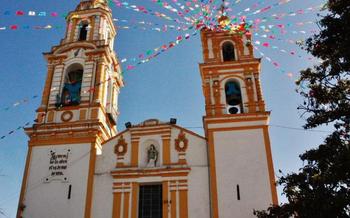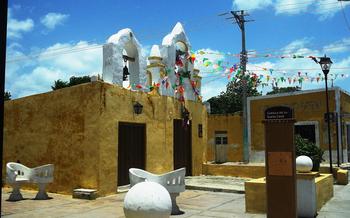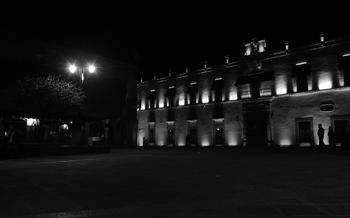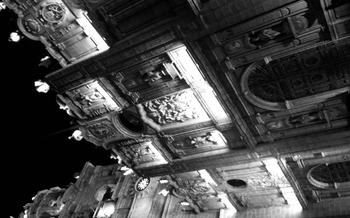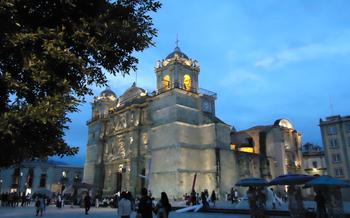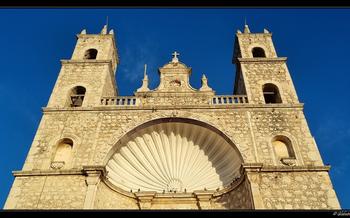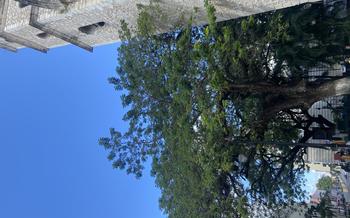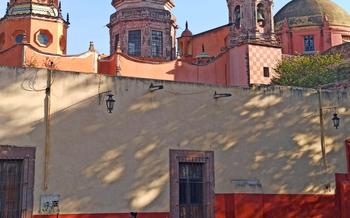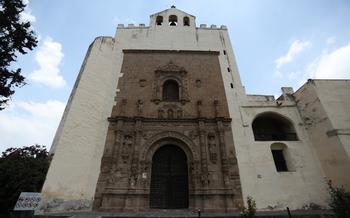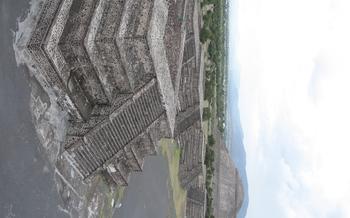
Capilla de la Paz (Chapel of Peace)
- Capilla de la Paz (Chapel of Peace): A Sacred Haven in Acapulco stands as a testament to Acapulco's rich history and enduring faith. Constructed in the 16th century, this sacred edifice holds immense significance for both religious and cultural reasons, becoming an integral part of the city's identity. The chapel's architectural splendor, its role in Acapulco's history, and its profound religious importance make it a must-visit destination for travelers seeking spiritual enlightenment and cultural immersion.
- Architectural Marvels
- Unique Design
- Intricate Details
- Notable Features
- Representation of Mexican Baroque Style
- Religious Significance
- Cultural Importance
- Visiting the Chapel
- Exploring the Interior
- Mass and Services
- Photography and Documentation:
- Guiding Tours: Unveiling the Chapel's Secrets
- Local Festivals and Events:
- Combining History and Leisure
- Respect and Etiquette
- Insider Tip: Unveiling Hidden Gems
Capilla de la Paz (Chapel of Peace): A Sacred Haven in Acapulco stands as a testament to Acapulco's rich history and enduring faith. Constructed in the 16th century, this sacred edifice holds immense significance for both religious and cultural reasons, becoming an integral part of the city's identity. The chapel's architectural splendor, its role in Acapulco's history, and its profound religious importance make it a must-visit destination for travelers seeking spiritual enlightenment and cultural immersion.
As a symbol of faith and resilience, the Capilla de la Paz has witnessed the ebb and flow of time, standing firm amidst the trials and tribulations faced by Acapulco over the centuries. Its enduring presence serves as a reminder of the city's unwavering devotion and the enduring power of spirituality.
Architectural Marvels
The Capilla de la Paz stands as a testament to the architectural brilliance of the Spanish colonial period. Its unique design blends elements of Gothic and Baroque styles, creating a visually striking masterpiece. The intricate details and notable features of the chapel are a testament to the skill and craftsmanship of the artisans who constructed it.
Unique Design
The chapel's distinct octagonal shape sets it apart from traditional Christian churches. This innovative design allows for a more intimate and immersive experience for visitors, creating a sense of closeness and connection with the sacred space.
Intricate Details
The facade of the chapel is adorned with intricate carvings and sculptures that depict scenes from the Bible and the lives of saints. The interior features a stunning altarpiece, adorned with intricate gold leaf and religious iconography. The walls are lined with colorful murals and frescoes, depicting biblical stories and the history of the chapel.
Notable Features
The chapel's dome is a remarkable architectural feature, rising high above the surrounding buildings and offering panoramic views of the city. The interior of the dome is painted with vibrant frescoes, creating a sense of awe and wonder. The stained glass windows, with their intricate designs and brilliant colors, illuminate the chapel with a warm and inviting light.
Representation of Mexican Baroque Style
The Capilla de la Paz is a prime example of the Mexican Baroque style, which flourished during the 17th and 18th centuries. This style is characterized by its exuberant ornamentation, dramatic lighting effects, and the integration of indigenous and Spanish influences. The chapel's architecture perfectly embodies these characteristics, making it a significant representation of Mexican Baroque architecture.
Religious Significance
The Capilla de la Paz holds immense religious significance as a sacred site dedicated to the veneration of the Virgin of Guadalupe, the patron saint of Mexico and Acapulco. This devotion has transformed the chapel into a pilgrimage site, where believers from near and far flock to pay homage to the beloved Virgin. Throughout the year, religious ceremonies and events are held within the chapel, drawing devotees who seek comfort, guidance, and spiritual connection. For locals and visitors alike, the Capilla de la Paz serves as a beacon of faith, reminding them of the enduring power of religion and spirituality in Mexican culture.
Cultural Importance
The Capilla de la Paz stands as a testament indigenous and Spanish influences that shaped the region's identity. The chapel's architecture, artwork, and religious practices reflect the deep-rooted traditions and beliefs of the local community.
As a symbol of Mexican heritage, the Capilla de la Paz holds a special place in the hearts of the people of Acapulco. It represents the continuity of cultural traditions and the resilience of the local spirit. The chapel is an integral part of local celebrations, religious festivals, and community gatherings, serving as a focal point for cultural expression and unity.
Through its unique blend of indigenous and Spanish elements, the Capilla de la Paz showcases the cultural diversity and richness of Acapulco. It represents the city's historical journey and its vibrant cultural identity, making it a beloved landmark and a source of pride for the local community.
Visiting the Chapel
The Capilla de la Paz welcomes visitors with open arms, inviting them to immerse themselves in its sacred atmosphere. To ensure a respectful and enriching experience, it is essential to adhere to the chapel's guidelines. Visitors are requested to observe the posted hours of operation, which may vary depending on the season and special events. Admission to the chapel is generally free of charge, allowing everyone the opportunity to experience its beauty and spirituality. A modest dress code is recommended, reflecting the chapel's religious significance. Visitors should avoid wearing shorts, tank tops, or revealing clothing out of respect for the sacred space. Additionally, it is important to maintain a respectful demeanor, speaking softly and refraining from disruptive behavior. By following these simple guidelines, visitors can contribute to the peaceful and reverent atmosphere of the Capilla de la Paz.
Exploring the Interior
Venturing inside the Capilla de la Paz reveals a treasure trove of artistic and religious wonders. The intricately carved altarpiece takes center stage, adorned with exquisite sculptures and paintings that depict scenes from the life of Jesus Christ and the Virgin Mary. The stained glass windows cast a kaleidoscope of colors onto the interior, creating a mesmerizing and spiritual atmosphere. Murals and frescoes grace the walls, narrating biblical stories and showcasing the artistic prowess of local craftsmen. Hidden details and unique features are scattered throughout the chapel, waiting to be discovered by observant visitors. Whether you're a devout believer or simply an art enthusiast, the interior of the Capilla de la Paz promises an awe-inspiring and enriching experience.
Mass and Services
The Capilla de la Paz is not only a historical and architectural marvel but also a vibrant center of religious devotion. Regular masses and services are held within its sacred walls, providing an opportunity for locals and visitors to come together in prayer and worship. The schedule of masses and religious services is available at the chapel or through local tourism offices.
Attending a mass at the Capilla de la Paz is a truly immersive experience. The melodious hymns, the scent of incense, and the palpable sense of spirituality create an atmosphere of serenity and devotion. Visitors are welcome to participate in the local traditions and rituals, such as lighting candles or offering prayers at the altar.
For those seeking a deeper spiritual connection, the chapel also offers opportunities for private prayer and reflection. Visitors can find solace and comfort within the tranquil surroundings of the chapel, taking a moment to connect with their inner selves and seek divine guidance.
Photography and Documentation:
Capturing the essence of the Capilla de la Paz through photography is a wonderful way to preserve memories and share the beauty of this sacred space with others. However, it's important to be respectful of the religious nature of the chapel and to adhere to the following guidelines:
Permitted Areas for Photography:
Photography is generally permitted within the chapel, but there may be certain areas or objects that are restricted. It's advisable to ask for permission before taking photos of sensitive areas, such as the altar or the sacristy.
Respect for Religious Practices and Privacy:
While taking photos, be mindful of ongoing religious ceremonies or services. Avoid using flash or making loud noises that may disrupt the proceedings. Respect the privacy of individuals who may not wish to be photographed.
Capturing the Beauty and Essence of the Chapel:
To capture the best shots of the chapel, take advantage of the natural light that streams through the stained glass windows. Experiment with different angles and perspectives to highlight the unique architectural features and intricate details. Remember to capture both the grandeur of the overall structure and the intimate details that make the chapel truly special.
Guiding Tours: Unveiling the Chapel's Secrets
To truly appreciate the historical, architectural, and religious significance of the Capilla de la Paz, consider embarking on a guided tour. Knowledgeable guides offer insights that bring the chapel's story to life, shedding light on its construction, dedication, and role in Acapulco's rich tapestry.
With a guide, you'll delve into the intricacies of the chapel's design, discovering the symbolism behind every arch, mural, and stained glass window. They'll point out hidden details that might otherwise go unnoticed, revealing the chapel's unique character and the artistic mastery that went into its creation.
Guided tours also provide a deeper understanding of the religious significance of the chapel. You'll learn about the patron saint, the pilgrimage traditions associated with the chapel, and the spiritual importance it holds for locals and visitors alike.
Whether you're a history buff, an architecture enthusiast, or simply seeking a deeper connection to the spirit of Acapulco, a guided tour of the Capilla de la Paz is an enriching experience that will leave you with a lasting appreciation for this sacred haven.
Local Festivals and Events:
The Capilla de la Paz is not just a place of worship but also a vibrant hub for local festivals and events. Throughout the year, the chapel becomes the heart of religious celebrations, cultural performances, and traditional rituals that showcase the rich heritage of Acapulco.
One of the most significant events is the annual Feast of Our Lady of Peace, held on December 12th. Devotees from all over the region gather to honor the patron saint of the chapel with processions, masses, and traditional dances. The chapel is adorned with colorful decorations, and the air is filled with the sound of music, prayers, and laughter.
During Holy Week, the chapel hosts special ceremonies and reenactments depicting the Passion of Christ. Locals and visitors alike participate in these solemn processions, carrying crosses and candles as they commemorate the crucifixion and resurrection of Jesus.
Beyond religious observances, the chapel also serves as a venue for cultural events, such as art exhibitions, concerts, and dance performances. These events provide a platform for local artists to showcase their talents and share their cultural heritage with the community.
Attending these local festivals and events is an exceptional opportunity to immerse yourself in the vibrant culture of Acapulco and experience the deep devotion and traditions that are an integral part of the city's identity.
Combining History and Leisure
A visit to the Capilla de la Paz is not only a spiritual journey but also an opportunity to explore the rich history and vibrant culture of Acapulco. The chapel's proximity to other attractions makes it easy to combine spiritual exploration with leisure and entertainment.
Within walking distance, visitors can discover the Museo Histórico de Acapulco, showcasing the city's history from pre-Hispanic times to the present day. The Fuerte de San Diego, a 17th-century fortress, offers stunning views of the bay and a glimpse into Acapulco's colonial past.
For a more immersive cultural experience, head to the Diego Rivera Mural Museum, featuring the artist's iconic murals depicting Mexico's history and culture. The Zócalo, Acapulco's main square, is a lively hub with colorful markets, street performers, and traditional restaurants.
Combining a visit to the Capilla de la Paz with these nearby attractions allows visitors to gain a deeper understanding of Acapulco's rich heritage while also enjoying the city's vibrant atmosphere. History buffs, art enthusiasts, and culture seekers will find plenty to explore and appreciate in this dynamic city.
Respect and Etiquette
When visiting the Capilla de la Paz, it is essential to observe proper conduct and etiquette to ensure a peaceful and reverent atmosphere. As a sacred space, the chapel holds great significance for locals and visitors alike, and it is important to respect religious customs and beliefs.
Visitors should dress modestly, avoiding revealing or overly casual attire. Silence and contemplation are encouraged within the chapel, and it is considered disrespectful to engage in loud conversations or disruptive behavior. It is also important to refrain from touching or handling religious artifacts or decorations unless explicitly permitted.
Taking photographs is generally allowed, but visitors should be mindful of the privacy of others and avoid using flash or creating disturbances during religious services or ceremonies. It is always advisable to ask permission before taking pictures of individuals or groups.
By observing these guidelines, visitors can contribute to the preservation and appreciation of the Capilla de la Paz, ensuring that it remains a sacred and welcoming space for all.
Insider Tip: Unveiling Hidden Gems
Discover the secret spots that offer breathtaking views of the Capilla de la Paz and Acapulco's stunning coastline. Venture beyond the main tourist areas to uncover hidden gems and lesser-known attractions that reveal the true essence of the city. Engage with locals to receive recommendations for authentic experiences, such as traditional markets, local eateries, and vibrant cultural events. Immerse yourself in the vibrant tapestry of Acapulco's history, culture, and natural beauty, creating memories that will last a lifetime.
